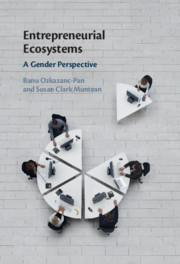Book contents
- Entrepreneurial Ecosystems
- Entrepreneurial Ecosystems
- Copyright page
- Contents
- Tables
- Preface
- 1 Introduction
- 2 Entrepreneurial Ecosystems
- 3 Understanding Gender and Inclusion in Entrepreneurial Ecosystems
- 4 Individual-Level Dynamics
- 5 Organizational-Level Dynamics
- 6 Gendering Institutions and Institutional Analysis
- 7 Intersectional Analysis
- 8 Holistic Solutions for Inclusive Economic Development through Entrepreneurship
- Index
- References
1 - Introduction
Published online by Cambridge University Press: 20 October 2021
- Entrepreneurial Ecosystems
- Entrepreneurial Ecosystems
- Copyright page
- Contents
- Tables
- Preface
- 1 Introduction
- 2 Entrepreneurial Ecosystems
- 3 Understanding Gender and Inclusion in Entrepreneurial Ecosystems
- 4 Individual-Level Dynamics
- 5 Organizational-Level Dynamics
- 6 Gendering Institutions and Institutional Analysis
- 7 Intersectional Analysis
- 8 Holistic Solutions for Inclusive Economic Development through Entrepreneurship
- Index
- References
Summary
The first chapter provides an overview of the rise and popularity of entrepreneurship as a practice and as a scholarly field of research. It notes how entrepreneurship has been shown to contribute positively to economic development and that scholarship related to supporting entrepreneurs through building robust entrepreneurial ecosystems is on the rise. Entrepreneurial ecosystems can be defined as a community of entrepreneurs engaged in reciprocal social and economic exchanges in the context of intermediary organizations, other actors, and institutions. Such research has focused on theory refinement as well as the development of metrics and ‘playbooks’ for communities that want to foster entrepreneurship. While policymakers are increasingly support building successful entrepreneurial ecosystems in their cities and states through public funding, there continues to be a dearth of research that addresses the relevance of gender for understanding and supporting entrepreneurial ecosystems. This chapter emphasizes the relevance and importance of a gender perspective for understanding how and why entrepreneurial ecosystems may not benefit female entrepreneurs in the same ways that they benefit male entrepreneurs. It provides insights into the ways a gender perspective can contribute to a new conceptual model of entrepreneurial ecosystems and eventually lead to effective policies for inclusive economic development.
- Type
- Chapter
- Information
- Entrepreneurial EcosystemsA Gender Perspective, pp. 1 - 28Publisher: Cambridge University PressPrint publication year: 2021



